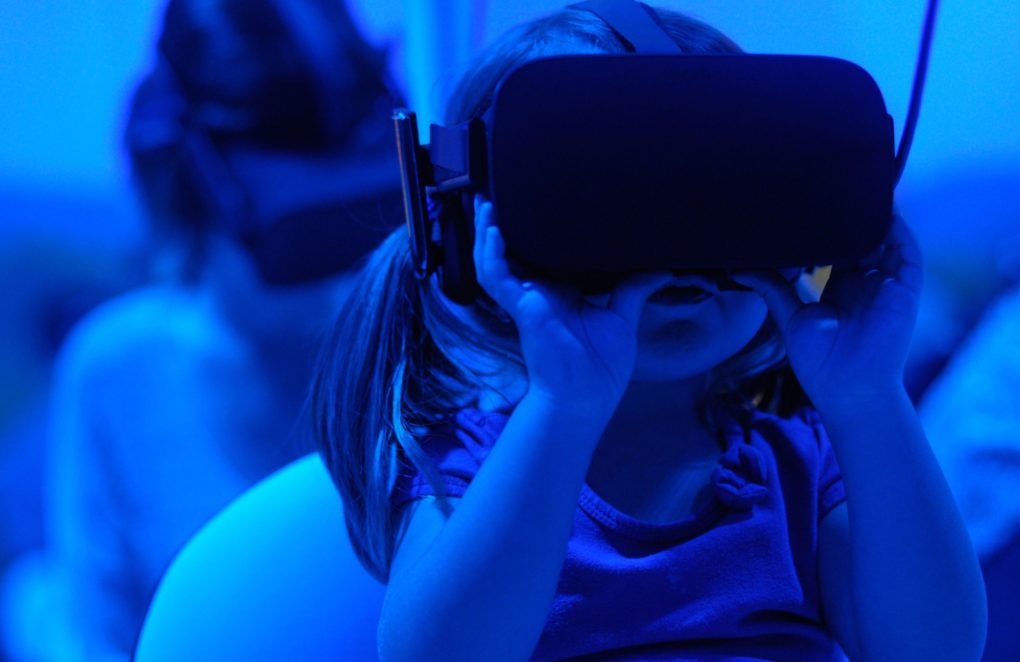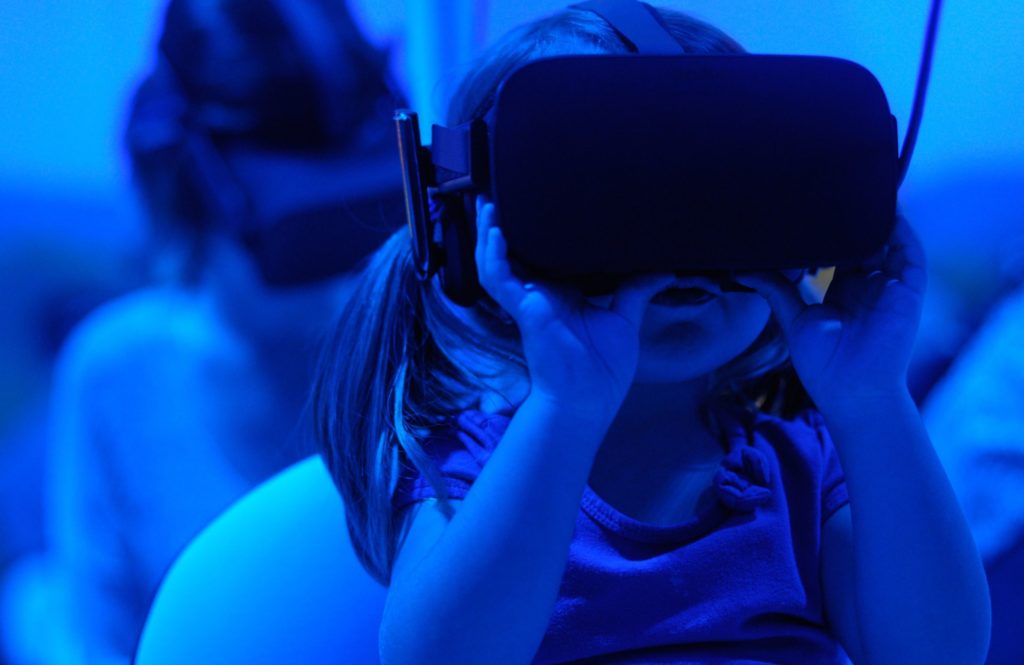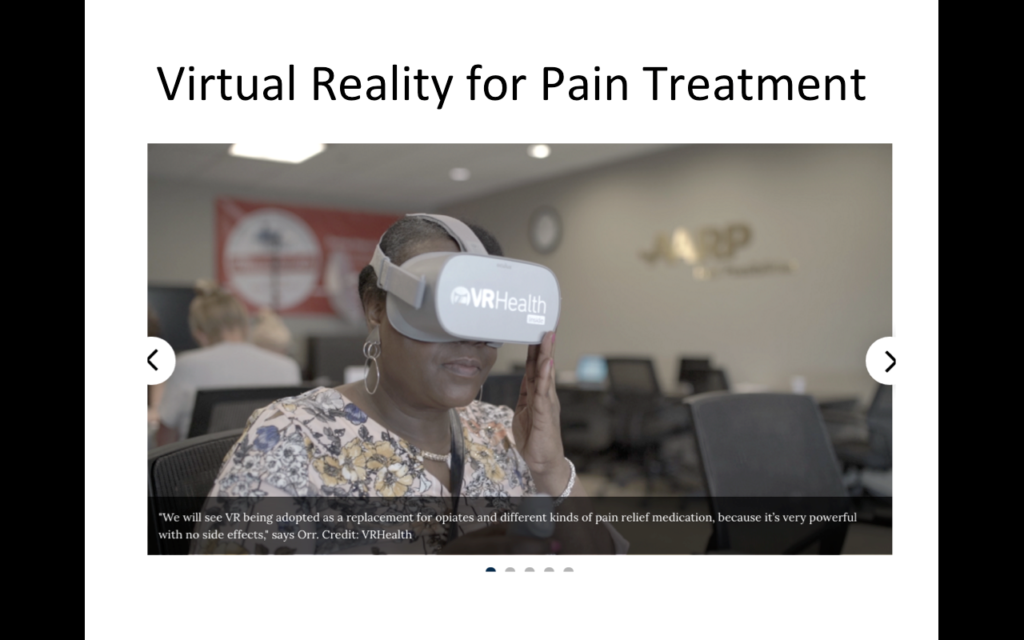Virtual Reality Shows Promise for Pain Patients; This is Exactly Why It Should Not Be Used in Schools
Many groups are promoting the use of Virtual Reality as a treatment strategy for pain patients. For example, VR is promoted as an alternative to opiates, “because it’s very powerful with no side effects.”
Widget not in any sidebars
According to Uploadvr.com,
More than 11 percent of Americans (that is 25 million people) suffer from chronic pain, with more and more of them relying on painkillers to make their everyday lives less of a struggle. Considering the opioid epidemic that plagues the country and claims the lives of almost 100 people on a daily basis, healthcare providers seek safer, non-addictive alternatives pronto. Perhaps, the solution could come from VR, as it has been found that virtual therapy can help reduce pain by 25 percent.
Medical VR (virtual reality therapy) has been evidenced to stop the brain from processing pain and reduce pain in hospitalized patients. This, in turns, shortens the length of the patient’s stay in the hospital, which also lowers the costs of care. Projects like Farmoo, have been created to help distract the minds of chronic patients and focus more on VR worlds that help them alleviate pain and release stress. They have the chance to escape the four walls of the hospital and swim together with whales in a beautiful ocean, join helicopter rides over wonderful landscapes in the Poles, or get involved in activities of a game, rather that their treatment, be it chemotherapy or any other.
In addition to assisting with pain patients, Virtual Reality-enhanced health care is being promoted for advancing autism care, relaxing hospitalized patients, restoring low vision, enhancing physician care to the elderly, speeding recovery after traumatic brain injury, and allowing medical students to observe surgeries.
Virtual Reality and Education
Additional applications for Virtual Reality, or Augmented Reality, range from training world-class athletes to airline pilots to race car drivers, to bringing VR into the classroom.
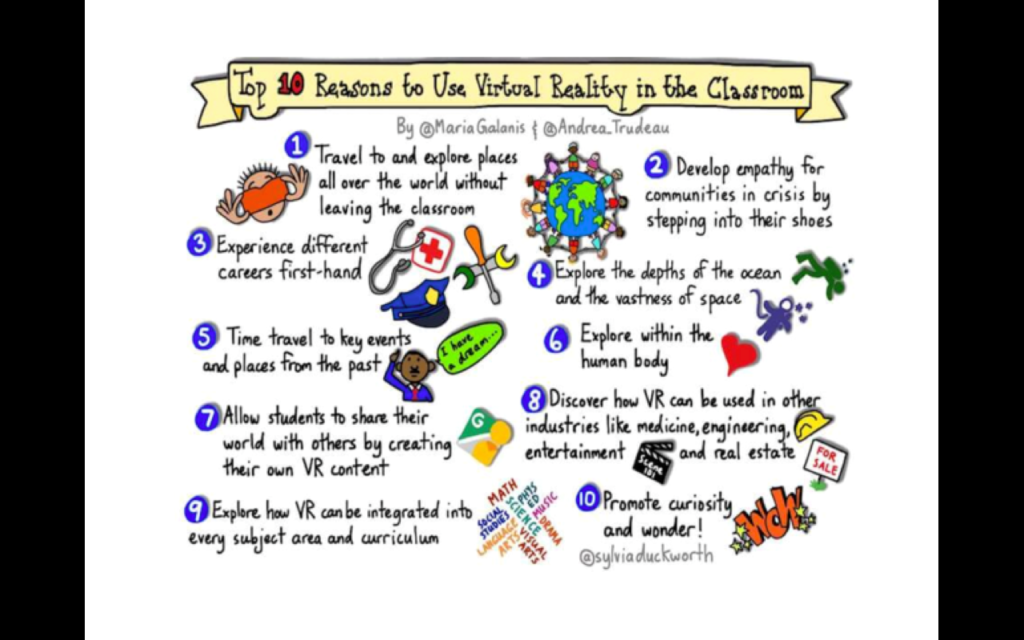
Source / Sylvia Duckworth, sketchnoter extraordinaire, put together a graphic of ideas from Maria Galanis and Andrea Trudeau on Top 10 Reasons To Use Virtual Reality
Teachthought.com offers “10 Reasons To Use Virtual Reality In The Classroom”
- Travel to and explore places all over the world without leaving the classroom.
- Develop empathy for communities in crisis by stepping into their shoes.
- Experience different careers first-hand.
- Explore the depths of the ocean and the vastness of space.
- Time travel to key events and places from the past.
- Explore within the human body.
- Allow students to share their world with others by creating their own VR content.
- Discover how VR can be used in other industries like medicine, engineering, entertainment and real estate.
- Explore how VR can be integrated into every subject area and curriculum.
- Promote curiosity and wonder.
Who is Thinking About Technology and Virtual Reality Downsides?
With a projected market of $33B by 2022, what is not to like about Virtual and Augmented Reality?
The health care profession notes, “Medical VR (virtual reality therapy) has been evidenced to stop the brain from processing pain and reduce pain in hospitalized patients.”
Virtual Reality stops the brain from processing pain because it overrides full-body and full sensory system intelligence and integration.
VR provides artificial feedback in the form of visual and auditory stimuli disconnected from the properties of the time-space continuum that living physiology also recognizes and interacts with, including gravity, magnetism, and time/space inputs that regulate body chemistry.
In the must-read first article of a new column in the Fair Observer, dubbed 3T, William Softky looks at why staring at screens is bad for humans.
Here are 10 interlocking reasons why using screens damages the human nervous system. The reasons are derived from basic mathematical principles of how matter and energy move in space and time.
The gist is that the human nervous system, seen as a sensitive instrument, needs to calibrate itself using natural patterns of matter and energy — natural and naturally representative data — while screens necessarily provide unnatural patterns (this is, synthetic and selected data), which severely damage the calibration process. (Scientific details are in the peer-reviewed paper, “Sensory Metrics of Neuromechanical Trust.”) The reasons are ordered with the most important ones at the end.
- Bad Light: Low-Contrast Blue
- Fixed Focus
- Oculocentric
- Too Smooth, Flat and Shiny
- Fractured in Space and Time; Pixelated: Flickering:
- Edge-enhanced
- Over-Attractive
- Sudden interruptions
- Persuasive In other words, the purpose of the technology is to control human perceptions, beliefs and behavior. People behave on average as if addicted to screens because their decisions, on average, are controlled by the screens. Persuasive technology does work, and it works by dangling just the right rewards at just the right times, using principles originally discovered with rats and cocaine levers. The main difference is that the “drug” that screens dispense is images, not chemicals. Habit-forming dopamine circuits work the same for both.
- Anti-Social Mobile video in general, and screen devices in particular, represent a peculiar technological pinnacle that works because it interferes with our perceptions and behaviors. Such technology cannot help being bad for us in large quantities.
Source: Fair Observer
Eyes As a Window to Neurological Function
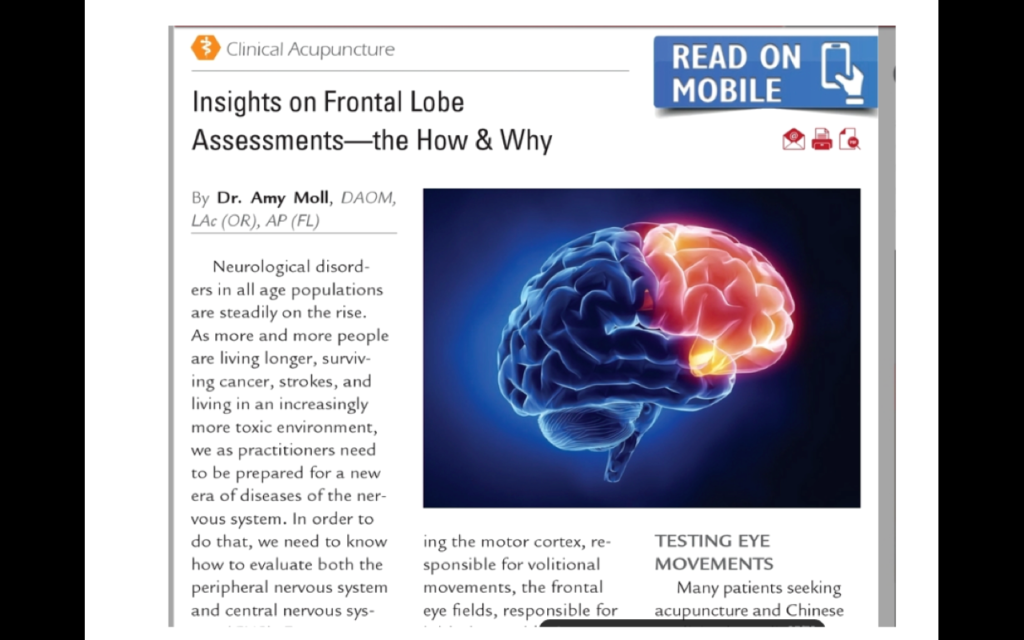 In the July issue of Acupuncture Today, author Amy Moll’s article “Insights on Frontal Lobe Assessments, Evaluating the Central Nervous System” describes how the eye function can be used to assess frontal lobe function, which is “responsible for executive functioning, the ability to plan, strategize, problem solve, analyze, and focus attention.”
In the July issue of Acupuncture Today, author Amy Moll’s article “Insights on Frontal Lobe Assessments, Evaluating the Central Nervous System” describes how the eye function can be used to assess frontal lobe function, which is “responsible for executive functioning, the ability to plan, strategize, problem solve, analyze, and focus attention.”
In the same way that a layperson can scan the pupils for signs of a stroke or concussion, a patient’s eyes can reveal further information about neurological functioning for health care practitioners.
The Eyes Have it: Saccades and Executive Function
From an evolutionary survival perspective, the human with the fastest capability to scan the environment for dangers, is the human that lives. The frontal eye fields allow for the quick initiation of saccade eye movements (rapid eye movements from one target to the next). In the human brain, it is possible for differences to be observed in brain output and processing speeds between the right and left frontal lobes. The case of concussion provides a good example of this, where it is often witnessed that neurological examination findings of the right frontal lobe differ from findings on the left.
The Eyes Have It: Anti-Saccades and Impulse Control
The Anti-Saccade Test
In contrast to the saccade, we have another eye movement called an anti-saccade. Anti-saccades provide an assessment window into the prefrontal cortex, the area related to executive functioning. In this test, stand in front of the patient, and hold up two index fingers shoulder-width apart, and in the same plane as your nose (not straight out in front of you). Instruct the patient to look at your nose, and when you wiggle a finger, instruct them to look at the opposite finger that is not moving, then return their gaze to your the nose. Wiggle your fingers in an unpredictable fashion, changing the rhythm as well as pattern. Humans are wired to want to look at visual movement, in order to determine if a sudden movement imposes any threat. In order to accurately perform an anti-saccade test, the patient has to have excellent impulse control, and that requires a healthy prefrontal cortex. Out of 10 times, how many times does a patient accidentally look at the wiggling finger instead of the still finger? If it is more than 3 out of 10, it is likely they are having some difficulty with prefrontal cortical function.
Would common sense indicate that screen time might be impacting the ways that these sensory systems function?
Several thousand years ago, devotional Chinese and Indian sages codified vast knowledge about the nature of the universe using only one tool – observation, enabled by an integrated human sensory system – the physical body itself.
The yogis used the dristi, or gaze point in poses, combined with specific breathing practices, to help train the mind-body connection for relaxed focus and attention.
Through the power of paying attention to their bodies in the context of the environment, the ancients worked to harmonize human endeavor with Laws of Nature. From knowing when to move livestock to when to till gardens to when to trim hooves and toenails to when to expect spring floods, wisdom was not dominated by the desire to monetize and commoditize consumer sentiment, surveillance, data and vast systems of sensors, or an end goal of accumulation (or concentration) of wealth.
The intent of the yogis to use the gaze point to integrate consciousness can be contrasted to the irony of texting while driving and the “solution” of installing a sensor to monitor driver vision. Throwing more technology at a problem caused by unwise use of technology is the new equivalent of throwing a new drug at the side effect of an inappropriately used drug, rather that seeking a more harmonious, non-harming, and healthy alternative catered to the individual’s constitution.
Unhinged Technology or Self Mastery and Reverence?
We are careening towards disembodied destruction, accompanied by massive consumption of resources, promoted as efficiency and sustainability.
The quest for big data is sourced from a basic lack of insight and understanding of the planet on which we reside, and from a desire for control.
IF we get back to basics, we can ask the right questions.
Virtual Reality is being promoted for:
- assisting with pain patients,
- advancing autism care,
- relaxing hospitalized patients,
- restoring low vision,
- enhancing physician care to the elderly,
- speeding recovery after traumatic brain injury,
- and allowing medical students to observe surgeries.
At the same time, the industry and its partners and society as a whole have not been willing to ask if VR and other new technologies are causing pain, for example, in the populations of medically vulnerable and environmental illness populations.
Is technology itself a cause or contributing factor in the autism epidemic in children (as well as rising rates of asthma, autoimmune illnesses, ADHD, and certain cancers?
Is technology and screen use harming eyesight?
Is technology, especially when used in proximity to the brain, causing or exacerbating neurological disease rates?
Viewed through the lens of eye function, should any child be expected to read while traveling on a moving school bus, while under the gaze of a surveillance camera?
Should any of this telecommunication technology be wireless, or are we unleashing electrical pollution even more harmful than asbestos?
There are two ways to decide how to envision the future for us, and for our children.
One choice is to assume that mind-body integration does not matter, and to relinquish our dopamine-serotonin biochemistry and consciousness to technology devoid of balance. We can overlook the fact that the blind adoption of technology into classrooms is a blank check for further monetization of disembodied learning.
The other pathway is to assume that children need a skillset for mastering their physicality with all of their senses, by being integrated, centered, and able to focus on both details and the big picture, and to interact with both joy and mastery with others in their environment, using all of their senses.
Unhinged technology is not needed in order to help children develop compassion for those in other countries by using VR; in fact, technology and social media is contributing to massive suffering and mental health issues across all age groups. There is a reason that tech’s VR is viewed as a wonderful weapon for war.
VR is promoted as an alternative to opiates, “because it’s very powerful with no side effects.” The loss of the ability to modulate our own consciousness and compassion is not a side effect; it is a degenerative illness in its own right.
Not being ready, willing, and able to assess to damage already being inflicted by technological drive devoid of reverence and balance is a state of disease.
Consciousness is the cure. Let’s take another look at the who, what, when, where and why of wireless technology and VR before we write another check for school budgets, or more 5G and telecommunications infrastructure, while we still can.
Technology arguably brings benefits, but the ubiquitous adoption of untested and unmonitored technology, unhinged from reasonableness, is both reckless and dangerous.
Virtual reality shows promise for pain patients; this is exactly why it should not be used in schools.
Top image credit: Giu Vicente/Unsplash
Subscribe to Natural Blaze for health freedom and natural living headlines to your inbox. Follow Natural Blaze on Twitter and Facebook.
